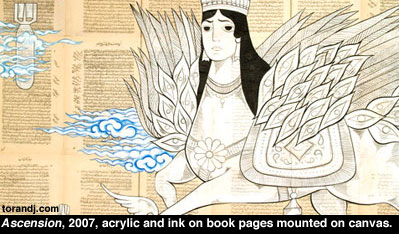به زبان فارسی
PICTORY
LATEST MUSIC
SEARCH
Cloudy, with a chance of war
by Azin Arefi
19-Aug-2007
They say that horses are the hardest animals to draw and that if you can do so, then you’ve got talent. By that definition Ala Ebtekar certainly has that—and then some. Horses run rampant and confident in his latest exhibit at Gallery Paule Anglim in San Francisco. These are battle horses, powerfully carrying soldiers into war. These are mythical centaurs, seemingly greeting soldiers when they die in war.
What is most appealing about Ebtekar’s work is that there are no gimmicks here, no “concept art,” but rather concept married with content. This is capacity on canvas. What is even more appealing about the work is that it does not look like something you have seen before, and yet there is something recognizable about it. An audience familiar with miniature paintings and the Iranian coffeehouse paintings will easily recognize their influence in Ebtekar’s work, which he has studied. What Ebtekar has done is to bring these two styles, one considered high-brow, the other low-brow, together and made it his own. That is one of the first tenants of any artist: make it new. The work is almost revolutionary in mixing and crossing class lines.
The contradictions continue: the work looks elegantly simple, and yet it is dizzyingly involved. Aside from the images themselves, one could spend uninterrupted minutes looking at (or reading, if one knows Farsi or Arabic) the book pages on which the images are drawn. The manuscripts are prayer books and religious texts Ebtekar found in Tehran and are at least 50-85 years old. “If you look closely” Ebtekar says, “you can see text formations in different shapes and directions, resembling a fabric of woven text, while the side notes and glosses are an addition to the book after it was written or published: readers added their own commentary, interpretation, and response to the text, similar to a wall scrawled with graffiti, or an internet blog. The text continues to accumulate as it is passed from one reader to the next in the course of its existence.” Leaving behind a piece on something you encounter is exactly what Ebtekar has done with these old manuscripts. Again, mixing high-brow and low-brow art, he has “graffitied” his war images on the pages to make them stunning canvases.
The images of war here are undeniably of the past, with strong, almost mythical, men with stronger moustaches, riding their horses into battle. Their uniforms are ornate and artistic, their horses elaborately decorated. But the art of war shifts with time: heroic men give way to clean-shaven soldiers in unimaginative uniforms, as if to say our modern wars are fought by naïve boys who carry gold keys around their necks, hoping to gain access to heaven when they die. The beautiful horses become cumbersome tanks. The art is no longer the men of war themselves but their powerful, deadly machinery that plunges down in a swirl of clouds from high above.
As an American-born Iranian, who has lived and studied in Iran, Ebtekar’s war images are influenced by the Iran-Iraq war. “My earlier works borrow a lot from the Iran-Iraq war. If you look closely at my earlier works you will see jet-planes and tanks that are direct references to the ones used in the Iran-Iraq War.” But war does not stop there for the globe, nor for Ebtekar. He explains: “When 9/11 happened I stopped working on this manner and felt as though I couldn't continue in that political climate. However when the current war was declared shortly after, I remember saying to myself I have to continue working, it’s actually more important to do it now than any other time. So I continued, and now the references are not solely from the Iran-Iraq war but from a larger body of sources and material that are coherent with contemporary geopolitical crises we are in.”
Ultimately it is impossible to stand before Ebtekar’s work and not have a reaction to it. And just as the reader completes the writer’s book, and the listener completes the composer’s piece, it is the audience that finishes the painter’s canvas. And getting people to think and talk about your work is an art form in itself.
***
Gallery Paule Anglim
ALA EBTEKAR
Exhibition Dates: August 1 - September 1, 2007
Gallery Hours: Tuesdays - Fridays, 10am to 5:30pm; Saturdays 10am to 5pm
Gallery Paule Anglim
14 Geary Street
San Francisco, CA 94108
Information: 415.975.0860, Fax: 415.433.1501, www.gallerypauleanglim.com
RECENT COMMENTS
IRANIANS OF THE DAY
| Person | About | Day |
|---|---|---|
| نسرین ستوده: زندانی روز | Dec 04 | |
| Saeed Malekpour: Prisoner of the day | Lawyer says death sentence suspended | Dec 03 |
| Majid Tavakoli: Prisoner of the day | Iterview with mother | Dec 02 |
| احسان نراقی: جامعه شناس و نویسنده ۱۳۰۵-۱۳۹۱ | Dec 02 | |
| Nasrin Sotoudeh: Prisoner of the day | 46 days on hunger strike | Dec 01 |
| Nasrin Sotoudeh: Graffiti | In Barcelona | Nov 30 |
| گوهر عشقی: مادر ستار بهشتی | Nov 30 | |
| Abdollah Momeni: Prisoner of the day | Activist denied leave and family visits for 1.5 years | Nov 30 |
| محمد کلالی: یکی از حمله کنندگان به سفارت ایران در برلین | Nov 29 | |
| Habibollah Golparipour: Prisoner of the day | Kurdish Activist on Death Row | Nov 28 |



